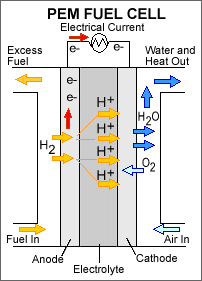Hydrogen Air / Oxygen Fuel Cell MEAs

 Hydrogen Air and Hydrogen Oxygen MEAs are used directly in Polymer Electrolyte Membrane Fuel Cells (PEMFC). They are designed to optimize the efficiency of portable applications as well as for stationary fuel cell applications. Their distinguishing features include lower temperature (20 to 80°C) and a special polymer electrolyte membrane. These MEAs allow for the proton to transport through the membrane while maintaining complete separation of the reactant fluids. Water is a key element needed in the membrane to allow for the proton to efficiently move across the membrane via the acid chains bound in the solid polymer membrane. Despite water being a critical aspect of this operation, too much water in the MEA area can cause problems with the reactant being able to reach the reaction sites effectively. Each reaction site must provide a pathway for the proton to move to/from the membrane, a pathway for the electron to move to/from the electrical circuit, and pathways for the reactant gases to reach the catalyst site and remove the excess water that is formed from the reaction.
Hydrogen Air and Hydrogen Oxygen MEAs are used directly in Polymer Electrolyte Membrane Fuel Cells (PEMFC). They are designed to optimize the efficiency of portable applications as well as for stationary fuel cell applications. Their distinguishing features include lower temperature (20 to 80°C) and a special polymer electrolyte membrane. These MEAs allow for the proton to transport through the membrane while maintaining complete separation of the reactant fluids. Water is a key element needed in the membrane to allow for the proton to efficiently move across the membrane via the acid chains bound in the solid polymer membrane. Despite water being a critical aspect of this operation, too much water in the MEA area can cause problems with the reactant being able to reach the reaction sites effectively. Each reaction site must provide a pathway for the proton to move to/from the membrane, a pathway for the electron to move to/from the electrical circuit, and pathways for the reactant gases to reach the catalyst site and remove the excess water that is formed from the reaction.
Our standard H2/Air and H2/O2 MEAs provide these aspects in a ready to use complete package as the 5-Layer MEAs. We also offer the standard MEAs without the gas diffusion layers (GDL) if you would like to use your own custom GDLs. The GDLs are what provide the electron pathways from the catalyst layer back to the rigid flow fields. These MEAs would be considered the 3-Layer or CCM (catalyst coated membrane) MEAs.
A few key differences between the H2/Air and the H2/O2 lie in the selected materials used for the MEAs. The H2/Air MEAs are produced with N212 and supported catalysts. The thinner membrane allows for lower resistances in the cell and the supported catalysts can be used to help lower the cost of the overall MEA. With only ~20% oxygen in air, the reactant supply for the cathode is significantly less reactive and therefore we can try to increase the performance slightly by reducing the resistance as much as possible. The H2/O2 MEAs are produced with N115 and pure catalysts. The thicker membrane provides better protection from inadvertent hydrogen/oxygen mixing. The pure catalysts provide more reaction sites for the overall reaction to occur and produce higher efficiencies.








